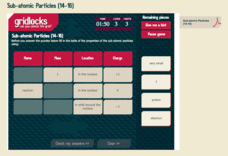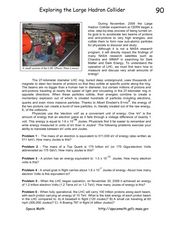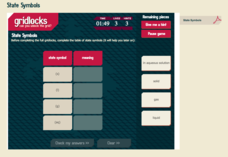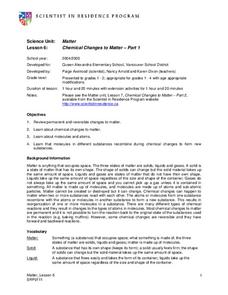Royal Society of Chemistry
Sub-Atomic Particles (14-16)
In 1897, J.J. Thomson discovered the electron, the first subatomic particle proven to exist. Scholars review their understanding of electrons, protons, and neutrons as they work through the puzzles. Each puzzle connects two or three...
Curated OER
Exploring the Large Hadron Collider
On this physics handout, pupils read about the Hadron Collider used to make new sub-atomic particles by accelerating protons. They solve 6 math problems that include translating electron volts to Joules. This is geared toward high school...
Curated OER
Calculating the Number of Sub-Atomic Particles in an Atom
In this atoms worksheet, students compare the position, relative charge and relative mass of sub-atomic particles. Students define mass number and atomic number. This worksheet has 2 graphic organizers and 4 short answer questions.
Curated OER
Sub-Atomic Particles and Energy
In this atomic particles activity, students complete an elements chart comparing atomic number, mass number, protons, neutrons, and electrons. Students write the electron configuration for atoms. This activity has 1 graphic organizer and...
Royal Society of Chemistry
Sub-shells
Is your class in a quandary over quantum numbers? Change things up by adding games to the mix! Science scholars discover the shape, number of electrons, and number of orbitals in the s, p, and d sub-shells using an interactive.
Curated OER
History of the Atom
This is a tremendous overview of the tiny atom. Journey through the history of human understanding of this basic building block of matter. Examine each of the sub-atomic particles in detail: neutrons, protons, electrons, quarks. Peruse...
Curated OER
Atomic Structure
In this atomic structure worksheet, high schoolers draw a helium atom and show the subatomic particles. They also answer questions about the Bohr model, Dalton's atomic theory and the energy of electrons based on their location in an atom.
Curated OER
Teaching Atomic Structure Using Cooperative Learning
Individuals in a group of four each take on a different role: atomic number expert, mass number expert, isotope expert, and nuclear atom expert. They teach each other about their area of expertise. As an assessment, a short quiz is...
Curated OER
Radiation Crossword Puzzle
In this radiation worksheet, learners complete a crossword puzzle by figuring out the vocabulary terms associated with the 25 clues given.
Royal Society of Chemistry
Moles Equations (14-16)
In chemistry, the mole is a unit of measurement, much like a millimeter or liter. After learning about moles, scholars learn various equations relating to mass, volume, and concentration. They review each of these equations in a few...
Royal Society of Chemistry
Forensic Tests
Flame tests determine if there is a specific metal in a chemical compound. Young forensic scientists review their understanding of flame tests and hydroxide precipitates by solving puzzles. The timed review encourages mastery.
Royal Society of Chemistry
State Symbols
When water is a solvent in a chemical equation, we consider it an aqueous solution. Scholars match the name of four states of matter to their proper symbol in a chemical equation. Four puzzles provide repetition to help pupils remember...
Royal Society of Chemistry
Units of Volume
Did you know in the UK a quart is smaller than in America? This explains why a standard unit of measure is necessary for volume. Young scientists learn the similarities and differences between five different units used to measure volume....
Royal Society of Chemistry
Types of Bonding
A covalent bond yells at an ionic bond, "Didn't anyone teach you to share?" Four matching puzzles allow pupils to review covalent, ionic, and metallic bonding. They apply logic and problem solving to complete gridlocks including the...
Royal Society of Chemistry
The Blast Furnace
The largest chemical reactors are blast furnaces, used to make iron from ore. Scholars explore reactants by first matching each one to its purpose and formula. Then, a series of three gridlock puzzles reinforce the content while...
Curated OER
Physical Changes to Matter
Pupils explore matter by conducting an in-class experiment. They experiment with water's various forms by melting and freezing water, identifying its new shape. These observations are recorded to supplement later discussion. They also...
Curated OER
Density and Mass
Students experiment to find which liquids are more dense. In this density and mass lesson plan, students predict and then test objects to observe and measure their density. students observe which items sink and float. Students complete...
Curated OER
Matter
Students recognize that some changes to matter are reversible and some are not. In this matter lesson, students experiment a physical and chemical change. Students record experiment results in their science journals. Students act out...
Curated OER
Mixtures of Matter
Students experiment with mixtures of matter. In this matter lesson, students investigate which liquids form a solution when mixed together and which do not. Students also identify which solids can be separated from matter.
Curated OER
Mixtures of Matter
Students experiment with solids and liquids. In this mixtures of matter lesson, students combine matter to form solutions. Students hypothesize, test, and analyze the data to draw conclusions. The lesson can be extended by having...





















